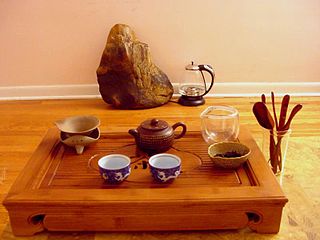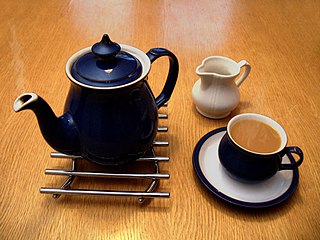 W
WA tea ceremony is a ritualized form of making tea practiced in East Asia by the Chinese, Koreans and Japanese. The tea ceremony, literally translated as "way of tea" in Japanese, "etiquette for tea" or "tea rite" in Korean, and "art of tea" in Chinese, is a cultural activity involving the ceremonial preparation and presentation of tea. The Japanese tea ceremony was influenced by the Chinese tea culture during ancient and medieval times, starting in the 9th century when tea was first introduced to Japan from China. One can also refer to the whole set of rituals, tools, gestures, etc. used in such ceremonies as tea culture. All of these tea ceremonies and rituals contain "an adoration of the beautiful among the sordid facts of everyday life", as well as refinement, an inner spiritual content, humility, restraint and simplicity "as all arts that partake the extraordinary, an artistic artificiality, abstractness, symbolism and formalism" to one degree or another.
 W
WThe Book of Tea by Okakura Kakuzō (1906) is a long essay linking the role of chadō (teaism) to the aesthetic and cultural aspects of Japanese life.
 W
WThe Korean Tea Ceremony or darye (茶禮) is a traditional form of tea ceremony practiced in Korea. Darye literally refers to "etiquette for tea" or "tea rite" and has been kept among Korean people for over a thousand years. The chief element of the Korean tea ceremony is the ease and naturalness of enjoying tea within an easy formal setting.
 W
WTea culture is defined by the way tea is made and consumed, by the way the people interact with tea, and by the aesthetics surrounding tea drinking.
 W
WA teahouse or tearoom is an establishment which primarily serves tea and other light refreshments. A tea room may be a room set aside in a hotel especially for serving afternoon tea, or may be an establishment which only serves cream teas. Although the function of a tearoom may vary according to the circumstance or country, teahouses often serve as centers of social interaction, like coffeehouses.
 W
WUji tea is a common name for all Japanese green tea produced from Uji, Kyoto. The 3 main types of Uji tea are Matcha, Sencha and Gyokuro. Japanese tea is originated from the Tang Dynasty of China, which is during the Heian period of Japan when Chinese influences were at its peak. When tea seeds were introduced to Japan, they were first planted at Toganoo. These seeds were later spread in Uji, which became the site to produce the highest quality of tea leaf in Japan.
 W
WSince the 18th century, the United Kingdom has been one of the world's largest tea consumers, with an average annual per capita supply of 1.9 kilograms (4.2 lb). Originally an upper-class drink in Europe, tea gradually spread through all classes, eventually becoming a common drink. It is still considered an important part of the British identity and is a prominent feature of British culture and society.